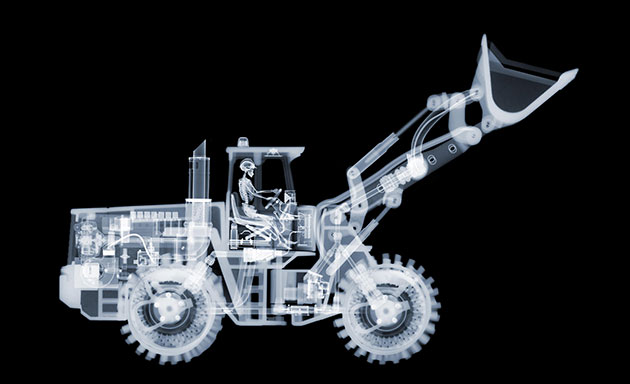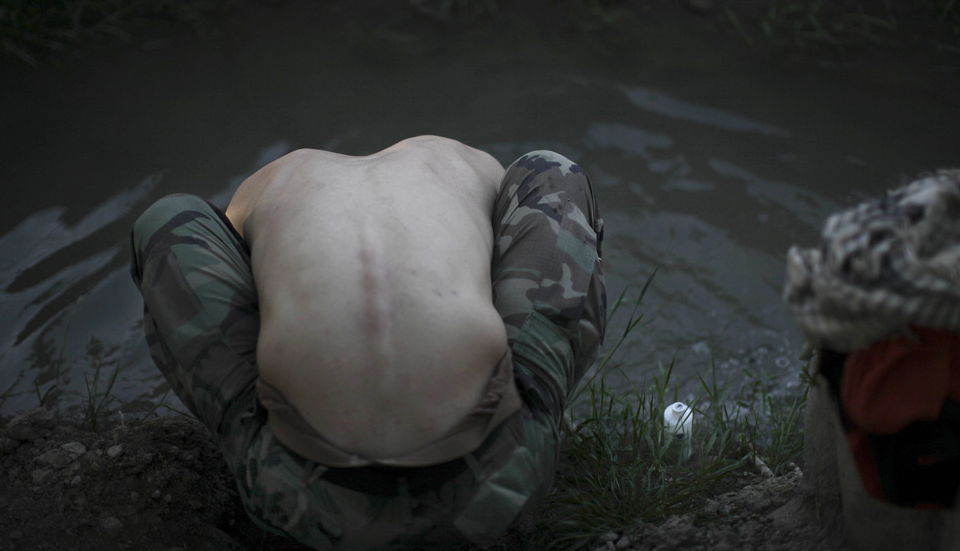With the introduction of X-ray body scanners at airports, there has been plenty of talk about how much of one’s personal life might be exposed. That roll around the middle, the glitter on the underwear, and Lord knows what medical or erotic devices–well, actually, more than the Lord will know, and that is the problem. Once again modern surveillance technology is likely to prove to be a devil’s bargain: too much information that we don’t really need, to reduce privacy and promote anxiety, on behalf of security that probably is illusive. One can’t help but feel exposed; like this, perhaps:

You are looking at an X-ray image of a payloader and operator that was taken by a cargo scanner. Some viewers of a certain age may find themselves peering into the guts of the machine to see how many parts they can identify. Others might look at the driver and be a bit shaken, as there doesn’t seem to be much to the human being. Small, thin-boned, almost insect-like, it seems more a sci-fi species than a person. Indeed, the machine is the far greater animal, while the operator seems reduced to being part of the machine, and both are fused together by the uniform industrial imaging into a single cyborg.
This precisely articulated exposure of that is beneath the skin isn’t quite uncanny, although it is a bit strange, as X-rays typically are strange and we don’t often see large machines though that lens. I think the full value of the image goes well beyond both its aesthetic qualities and its novelty, however. Something else is being exposed: one of the porous borders of human being. Or, to be a bit more up to date: one side of the posthuman. Instead of defining human being as a fixed essence (as with a soul) that is fundamentally different from all other animals, on the one hand, and from all machines and other technologies, on the other hand, the posthuman considers how humanity is both more variable across time and other dimensions, and how it is more continuous with both nature and technology. Again: humans are not defined solely by their intelligence and so are embodied creatures like all other species, and they are defined and changed by the technologies that they create to alter and control the rest of the world.
Photography has been celebrated for its ability to portray humanity and so to celebrate humanism. Think of The Family of Man exhibition, for example, or the many celebrations of the human face. And so it does, but I think it is time to start considering how photographs may occasionally be moving beyond humanism to reveal various hints of the posthuman. Like this, to take another example:

The caption said that this Marine was washing his head during an operation in southern Afghanistan. His head, of course, is nowhere to be seen. Instead we have an acephalic figure, one still demonstrably human–we recognize the back and clothing as such–but also disturbingly not human–that is, as long as one grounds humanness in the possession of a mind rather than simply an animal body having a familiar form. Until the photo above, this image seems to be all body rather than design, and all skin (literally and the second skin of his uniform)–but not quite, for the spine extrudes partially, signifying his skeleton and the cord of nerves than runs through every vertebrate. None of this is particularly reassuring, however. He is too much a brute animal in some primitive crouch at the water hole. But, of course, that is a bottle of soap beside him, and he is cleaning himself, and he is human, but also posthuman, squatting, thanks to the photograph, at another border of the species, though not to lose his soul.
Photographs by Nick Veasey/Caters News Agency Ltd. and Maurico Lima/AFP-Getty Images.
Check out the work of Chris Cunningham.